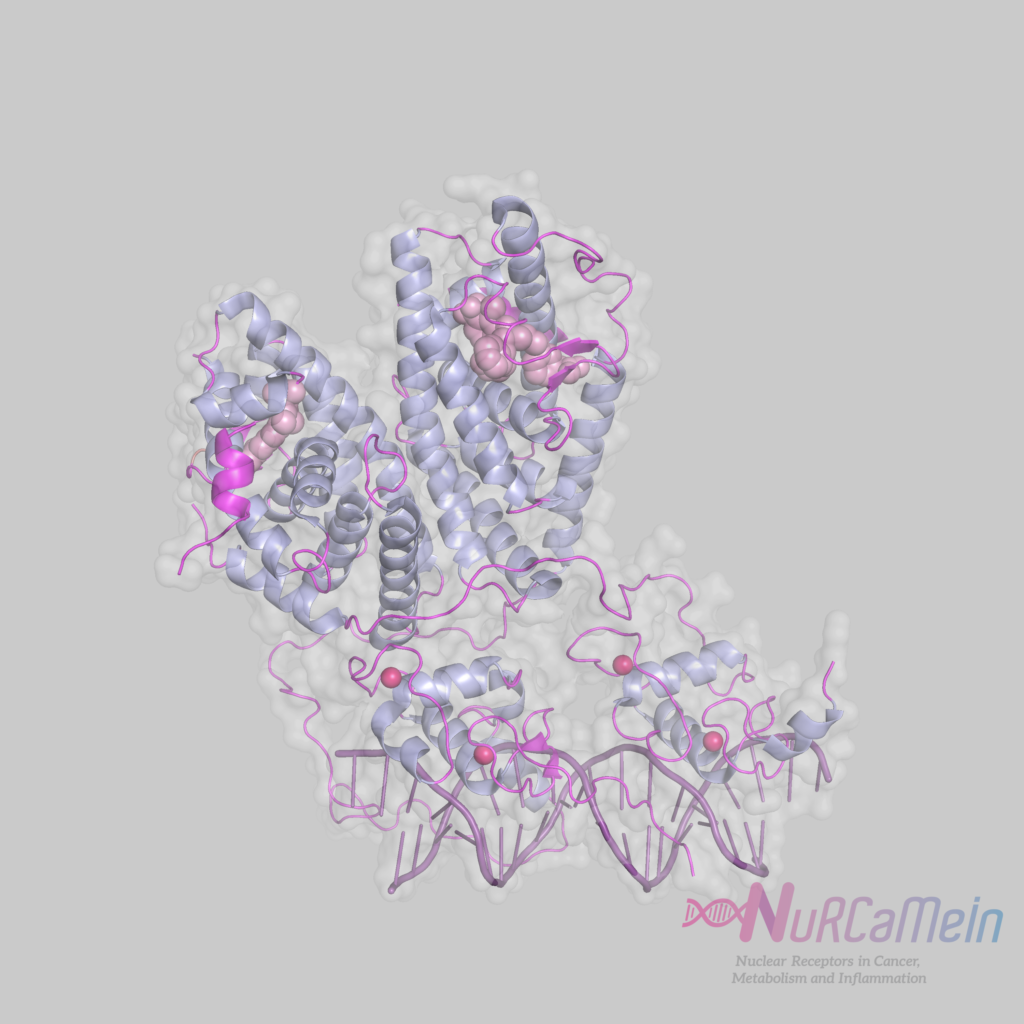LXR (LIVER X RECEPTOR)
Liver X receptors (LXRs) are ligand-dependent transcription factors that regulate gene expression of genes that play a crucial role in the metabolism of cholesterol and other lipids, and in the regulation of macrophage activity.
Ligands
The main ligands of LXRs are oxysterols (oxygenated derivatives of cholesterol) and other intermediary metabolites of cholesterol metabolism.
Classification
LXRs are members of the NR1 subfamily, the large nuclear receptor (NRs) superfamily, along with other receptors such as TRs, VDRs, RARs or PPARs.
In turn, based on their affinity for the ligand and its mode of action, they are classified as “adopted” and Type II receptors.
Structure and interactions
- A / B domain (NTD / AF-1): coactivators binding region in the N-terminal position, with DNA transactivation function (AF-1), being able to operate dependently or independently of the ligand.
- C domain (DBD): Highly conserved DNA binding region, containing two “zinc fingers” that interact with specific hormonal response elements (HREs motifs, in this case called LXREs), and mediating receptor dimerization .
- D Domain or “hinge region”: region that unites domains C and E, and which gives flexibility to the receptor.
- E / F domain (LBD / AF-2): region of ligand binding and interaction with coactivators and corepressors (ligand-dependent AF-2 transactivation function), in C-terminal position.

LXR structure
In the absence of ligand, the LXRs are linked to the LXRE motifs, associated in turn with corepressor proteins, repressing the expression of the target genes. The binding of the ligand (agonist) to the receptor induces a conformational change in the LBD domain, which results in the dissociation of corepressors and the recruitment of coactivators that activate gene transcription.
LXRs form heterodimers with X retinoid receptors (LXR / RXR) in a “permissive” manner, as they can be activated by LXR and RXR agonist ligands, such as 9-cis-retinoic acid (AR, vitamin A metabolite).
Expression
There are two isoforms of LXR: alpha (LXRα) and beta (LXRβ). Both share a high percentage of homology in the DBD and LBD domains, and play a key role in the metabolism of liver lipids.
LXRαs are highly expressed in the liver, intestine, adipose tissue, kidneys, adrenal glands, and macrophages. LXRβs are expressed ubiquitously throughout the body.
Main functions
Among the main functions of LXRs, one is to maintain lipid and glucose homeostasis by activating genes involved in reverse cholesterol transport and glucose metabolism. These receptors act as a cholesterol sensor, reducing its levels in the body through the regulation of target genes associated with reverse cholesterol transport, the conversion of cholesterol to bile acids and the absorption of intestinal cholesterol.
LXRs regulate certain biological activities of macrophages, so they are also involved in the immune and inflammatory response.
LXRs in the NuRCaMeIn Network
- Grupo de receptores nucleares | Dpto. de Biología celular, fisiología e inmunología de la Facultad de Biología de la Universidad de Barcelona (UB)
- Macrophages, LXR, Inflammation and Immune Response | Nurcamein
- Grupo de Señalización celular | Universidad de Barcelona, Facultad de Farmacia
- Nuclear Receptors, Inflammation, Diabetes, and Atherosclerosis | Nurcamein
- Laboratorio del Dr. Antonio Castrillo Viguera del Instituto de Investigaciones Biomédicas “Alberto Sols” | Centro mixto del Consejo Superior de Investigaciones Científicas (CSIC) y la Universidad Autónoma de Madrid.
- The Liver X Receptor, Lipid Metabolism, and Macrophages | Nurcamein
References
- Cholesterol Homeostasis and Liver X Receptor (LXR) in Atherosclerosis, Shuyuan Guo et al. | Cardiovascular & Hematological Disorders-Drug Targets
- Liver X Receptor Inverse Agonist SR9243 Suppresses Nonalcoholic Steatohepatitis Intrahepatic Inflammation and Fibrosis, Peng Huang et al. | BioMed Research International
- Liver X Receptors and Male (In)fertility, Sheba Jarvis et al. | International Journal of Molecular Sciences
